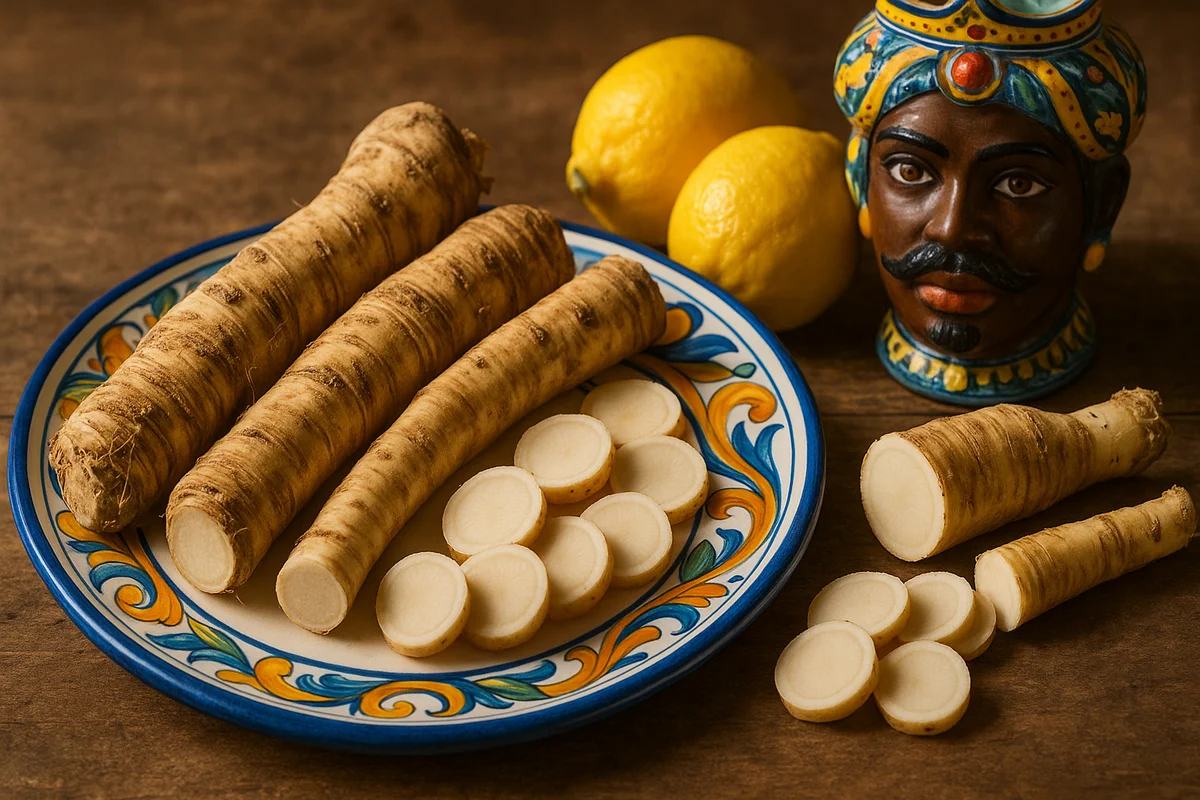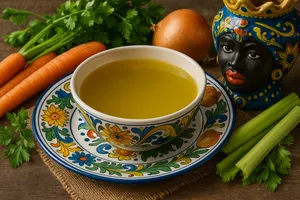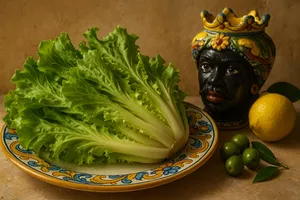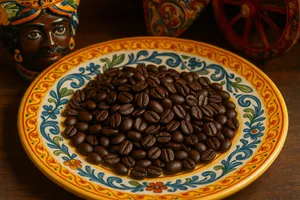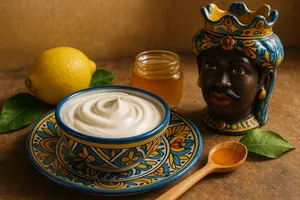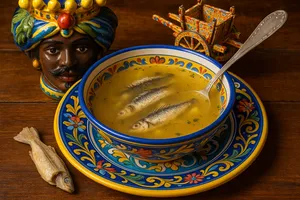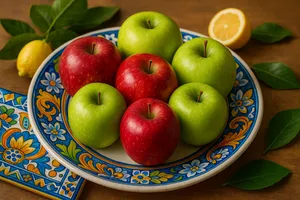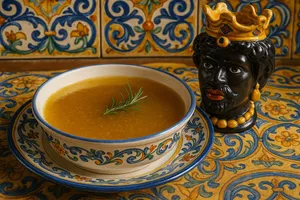Overview
Horseradish is a perennial herbaceous plant belonging to the Brassicaceae family, cultivated for its thick, fleshy root with an extremely pungent, spicy flavour. When freshly grated or ground, the root releases volatile compounds that create a powerful nasal and palate-burning sensation, similar yet distinct from mustard or chilli. In Sicilian cuisine, horseradish does not have an ancient tradition as in Central and Eastern Europe (Germany, Austria, Poland, Hungary), but it is appreciated as a flavourful condiment for boiled meats, smoked fish and modern sauces blending local tradition with international influences.
Fresh horseradish appeals to those who enjoy strong, assertive flavours capable of awakening otherwise delicate dishes. The root is grated immediately before use to preserve maximum pungency, as the volatile compounds responsible for its spiciness dissipate quickly. In Sicily, horseradish is more common in inland and mountainous areas where root vegetables are frequently grown and where culinary influences from the European mainland have penetrated. It is gaining renewed interest in contemporary Sicilian cuisine, used by chefs experimenting with bold pairings that bridge local tradition and global flavour. Understanding its power requires moderation and know-how.
Characteristics
Horseradish roots are elongated, cylindrical, beige-brown on the outside and creamy white inside. They typically measure 15–30 cm in length and 3–5 cm in diameter. The texture is firm, compact and fibrous, with a rough, irregular exterior.
The flavour is intensely hot and pungent, provoking tears and a burning nasal sensation. Pungency peaks immediately after grating and declines rapidly when exposed to air. Freshly grated horseradish has a bright white colour that oxidises quickly to greyish tones unless treated with vinegar or lemon. The aroma is strong, sharp and immediately recognisable.
High-quality horseradish feels firm and heavy, with an intact surface. The flesh should be compact and white, never dry, spongy or mouldy. The smell must be pungent yet clean, without sour or rotten notes.
Cultivation
Horseradish is a hardy perennial thriving in cool and temperate climates. It prefers deep, fertile, moist and well-drained soils. It is propagated by planting root cuttings (side shoots) in spring. Roots are harvested in autumn and winter after the first year, though older roots are larger and more flavourful.
In Sicily, cultivation is limited to mountain areas with cooler climates. It is not widespread as in northern Italian regions or Central Europe. Often it is grown in home gardens for personal use.
The plant forms large, rough leaves in a rosette and produces white flowers in clusters during summer, though it rarely sets seed due to its vegetative propagation. Only the main root is used for cooking.
Fresh horseradish vs prepared horseradish
Fresh horseradish: Whole root grated at the moment of use. Maximum heat, clean flavour, but requires immediate preparation. Oxidises quickly, losing colour and pungency.
Prepared grated horseradish: Sold in jars, grated and preserved in vinegar or oil. Less pungent but longer-lasting and convenient. The flavour is milder than the freshly grated root.
Horseradish sauce (cren): A traditional Central European preparation made of grated horseradish mixed with soaked breadcrumbs, vinegar, salt and sugar. It may include cream or grated apple for sweetness and a smoother consistency.
Culinary uses
Condiment for boiled meats
The classic use. Freshly grated horseradish accompanies boiled meats (mixed boiled cuts, tongue, head), enhancing their delicate flavours with its intense heat. Served on the side so each person can adjust quantity.
Sauce for smoked fish
Horseradish is a traditional pairing with smoked salmon, trout or mackerel. A sauce made of grated horseradish, sour cream, lemon and dill balances the fattiness of smoked fish.
Cocktail sauce
In modern Sicilian preparations, horseradish enriches cocktail-style sauces for prawns or seafood: mayonnaise, ketchup, grated horseradish, lemon and Worcestershire. Adds lively, spicy notes.
Carpaccio condiment
Very thin shavings of fresh horseradish (made with a mandolin or vegetable peeler) garnish meat or fish carpaccio, providing heat and crunch.
Enhanced salsa verde
Adding a little grated horseradish to traditional Sicilian salsa verde (parsley, capers, anchovies, garlic, vinegar, olive oil) gives extra pungency. Served with boiled meats or fish.
Horseradish mayonnaise
Mayonnaise enriched with grated horseradish is a modern condiment for gourmet sandwiches, burgers or tartare—creamy with a spicy kick.
Salads
A small amount of grated horseradish in salads, especially with beetroot, apples and walnuts, adds a bright, spicy note. Use sparingly to avoid overwhelming the other flavours.
Preparing fresh horseradish
To prepare fresh horseradish:
1. Peel the root, removing the rough outer layer.
2. Rinse the white flesh under water.
3. Grate finely (microplane or fine-hole grater) immediately before use.
4. To prevent oxidation, mix immediately with lemon juice or vinegar.
5. Use sparingly due to its extreme intensity.
Warning: the vapours released during grating are intensely irritating. Work in a well-ventilated area and keep your face away from the grater. The effect is stronger than onions.
Homemade horseradish sauce (cren)
Basic recipe:
1. Grate 100 g of peeled horseradish.
2. Soak 50 g of breadcrumbs in a little milk and squeeze.
3. Mix horseradish, breadcrumbs, 2 tbsp white vinegar, 1 tsp sugar and salt.
4. Add olive oil until creamy (or cream for a milder version).
5. Rest 30 minutes before serving.
6. Store refrigerated in a jar for up to 1 week.
Variations: add grated green apple for sweetness; add cooked grated beetroot for a pink Austrian-style sauce.
Storage
Fresh horseradish root keeps in the refrigerator (vegetable drawer) wrapped in damp paper or a perforated bag for 2–3 weeks. After that it dries out and loses pungency.
Once peeled or cut, it oxidises quickly and must be used at once. Peeled root may be kept submerged in vinegar for a few days, though pungency diminishes.
Grated horseradish may be frozen in small portions (with lemon to prevent oxidation), but some heat is lost. Acceptable for convenience.
Prepared horseradish sauce keeps refrigerated for about 1 week before losing intensity.
Buying tips
Choose firm, heavy roots with intact skin and no soft spots. Avoid dry, shrivelled or lightweight roots, which indicate age and loss of quality.
Fresh horseradish is usually available in autumn and winter. Out of season, jarred prepared horseradish is more common (check labels for simple ingredient lists without harsh preservatives).
Medium-sized roots are preferable: large roots last too long and lose pungency before being fully used.
Nutritional properties and benefits
Horseradish is low in calories: about 40–50 per 100 g. It contains mostly carbohydrates (mainly fibre), small amounts of protein and negligible fat. It is rich in vitamin C, vitamin B6, potassium, calcium, magnesium and phosphorus.
It contains glucosinolates, the compounds responsible for its heat, which have antibacterial, antifungal and antioxidant properties. Traditionally it has been used to stimulate digestion, relieve respiratory congestion and combat infections.
Moderate culinary use offers benefits without major drawbacks. Excess consumption may irritate the stomach or mucous membranes. Not suitable for people with gastric ulcers or sensitive digestion.
Horseradish in European tradition
Horseradish is fundamental in Central and Eastern European cuisines: Germany (Meerrettich), Austria (Kren), Hungary, Poland, Russia. It accompanies boiled meats, sausages and smoked fish. It is also part of Jewish culinary tradition (served with gefilte fish and during Passover as one of the bitter herbs).
In Italy, it is more common in northern regions (Trentino-Alto Adige, Friuli-Venezia Giulia, Lombardy) due to Austro-Hungarian influence. In Sicily, its use is more recent and limited, though growing thanks to renewed interest in strong flavours and international traditions.
Horseradish vs wasabi
Horseradish (Armoracia rusticana) and wasabi (Wasabia japonica) are different plants, though both belong to the Brassicaceae family and share a similar pungent flavour. Wasabi is native to Japan, has a more delicate and volatile aroma and is green in colour.
Many commercial “wasabi” products are in fact horseradish dyed green, as real wasabi is expensive and difficult to cultivate. Horseradish is therefore an accessible substitute with similar, though not identical, heat.
Curiosities
The Italian name “rafano” comes from the Latin raphanus (radish), though horseradish and common radishes are different plants. The linguistic confusion is ancient.
In the Middle Ages, horseradish was valued mainly as a medicinal plant used to treat infections, digestive issues and joint pain. Culinary use developed later, especially in Central Europe.
An old German saying goes: “Meerrettich macht den Toten lebendig” (“Horseradish brings the dead back to life”), highlighting its intense, awakening pungency.
In some Jewish traditions, horseradish is one of the bitter herbs (maror) consumed during the Passover Seder, symbolising the bitterness of slavery in Egypt.
Freshly grated horseradish quickly loses its heat due to the volatility of isothiocyanates, the compounds responsible for its pungency. Acidic ingredients (vinegar, lemon) help slow this loss.
In some Sicilian mountain villages, horseradish was occasionally grown in home gardens by families with ties to northern regions or those seeking hardy vegetables. It was considered a “foreign” plant but useful for expanding local flavours.
The heat of horseradish differs from chilli: horseradish affects the nose (volatile compounds), while chilli burns the mouth and tongue (capsaicin). They are complementary but not interchangeable.

